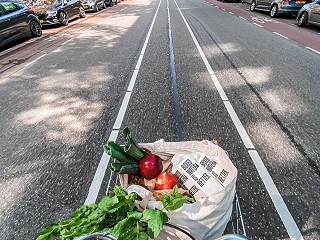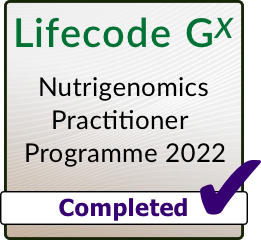Can you be healthy in the middle?

Books, magazines, and, yes, even your trusted nutritional therapist always have some handy, easy-to-follow advice to keep you healthy. “Just 5 minutes face yoga per day prevents wrinkles”, “get a flat tummy in just 10 minutes a day” or “a simple 30-minute walk at dawn ensures better sleep at night” … That’s 45 minutes before you have even started looking after the rest of your life or even cooked a meal. If you’re not a celebrity and cannot afford a chef, a personal trainer, and a housekeeper, it can be difficult to find the time.
Add to that the restrictiveness of advice - like “avoid all carbs”, “don’t eat sugar”, “don’t snack”, “avoid alcohol”, “count calories”-, which can seem impossible to stick to at all times, and you may feel inclined to not even start. Being healthy can seem like an impossible task.
Does it always have to be all or nothing?
Can you, perhaps, be “healthy in the middle”?
First of all, the more effort you invest in your health, the better the result. Of course, some people who live to 100 although they drink, smoke, live on crisps and chips, and the only body part they move is their finger on the remote.
Others seem to be doing everything right – perfect diet, exercise, fresh air, flossing, no stress – and still they are struck down by a heart attack at 54. We are not talking about those people. Some people are just lucky or unlucky.
But we know what is and isn’t good for us, and having a healthy, real food diet, cooking from scratch, putting in some regular exercise, getting out into fresh air, taking time for meditation or other relaxation, scheduling me-time does increase your chances of living a long and healthy life.
Having said that, you can also benefit from – even small - diet and lifestyle changes if you are not able to stick to all of the above at all times. And here’s why:
The Pareto Principle – aka the 80/20 Rule
The Pareto principle states that for many outcomes, roughly 80% of consequences come from 20% of the causes. It was named after the Italian economist Vilfredo Pareto who observed in 1896 that 80% of Italy’s wealth belonged to only 20% of the population. Surprisingly, it turned out that this principle can be applied in many other areas, too. Most things in life are not distributed evenly. For example:
• 20% of the workers produce 80% of the goods • 20% of the customers create 80% of the revenue • 20% of computer bugs cause 80% of the crashes • 20% of the clothes in people’s wardrobes are worn 80% of the time
Applied to health, this could mean: 20% of your lifestyle choices are responsible for 80% of your health outcomes. That would mean that small changes, or even a single one, could have a significant impact. If you are a smoker, just giving up smoking would greatly impact your health, your sense of smell, and your physical stamina, not to mention your finances.
If you drink alcohol most days and too much of it on many of those days, cutting back or – ideally - going sober would make a difference in how well you sleep, how much you weigh, how likely you are to suffer from heart disease, cancer, dementia or liver disease later in life.
If your life revolves around sugar, removing just that one substance from your diet could reduce pain and inflammation, put an end to cravings and binges, improve your mood and protect you from type 2 diabetes, hypertension, heart disease, dementia and depression.
I’m not saying that either of those changes would be easy, but you don’t have to turn your whole life around to be healthier in the future than you are now. If you decided today to become a health saint from tomorrow and were actually able to do that, then, yes, you may become 100% healthy. But how realistic is that? According to the Pareto principle, however, chances are (and it is not a law) that you may become a lot healthier with a lot less effort.
So, pick the one thing that bothers you the most, the one thing that you suspect has the strongest impact on your wellbeing and focus on that for now. It’s a place to start. Once you have truly conquered that, you can, if you want, move on and tackle the next thing – one step at a time.
Know yourself
How many times has a friend, or your partner shared a health tip with you that worked for them? Maybe your husband feels like a new man since he took up running. Maybe your friend swears by her early morning swim because it helped her start her days more energised, lose weight and be happier. But is this for you? If you don’t like running or the thought of jumping into cold water first thing in the morning fills you with dread, it probably isn’t, never mind how much good these things do for other people. If you don’t enjoy what you are doing, you are unlikely to stick to it. Simple as that.
If exercise is lacking from your life and you would like to change that, find a type of exercise that YOU will enjoy and do that instead. If you are not sure, try out different things. Think back to when you were a child: What did you love then? Could you revive that love you had for cycling? Would it be worth dusting off your rollerblades? Can you find an adult ballet class near you?
If you don’t like running, how about walking? A 2013 study concluded that “moderate (walking) and vigorous (running) exercise produced similar risk reductions for hypertension, hypercholesterolemia, diabetes mellitus, and possibly coronary heart disease.” The NHS recommends at least 150 minutes of moderate aerobic exercise per week. That’s just over 20 minutes every day or 30 minutes, five days a week. And it doesn’t have to be walking; pushing a lawnmower, dancing, or riding a bike all count. Anything that will increase your heart rate will do. If you find walking on your own boring, buddy up with a friend, listen to an audiobook while you do it, or use your time outdoors to look out for great motifs, if you enjoy photography.
Some people decide to cut out sugar and stop eating it there and then, either because they are the kind of person that will stick to resolutions or … because they know that having ONE biscuit will open the floodgates and they are not going to stop until they have demolished the entire packet. Others can’t face the thought of never having another biscuit – but they CAN stop after having just one every now and then. Which kind of person are you? Once you have established that, you can plan your strategy.
Set Goals
Research has found that people who have goals – particularly high or hard goals – are considerably more likely to succeed than people who do not. Ideally, those goals should be SMART:
Specific – be clear about EXACTLY what you want to achieve. “I will cook from scratch 5 times per week” is specific. “I will eat more home-cooked food” is not. Measurable – You can easily count the times you have cooked from scratch. You could even track it with a tick list. Attainable – If you’re working 10-hour days and have a two-hour commute, it may not be feasible to cook five times a week. But batch-cooking five meals on a weekend might be. Relevant – Is this goal relevant for you? Does it match your values? Why is it important to you? Timely – When do you want to achieve this by?
Now, you could write down a list of goals, every single one of them SMART. But is it feasible to reach them all? After all, the goal is just wishful thinking at this stage. You still have to actually do what it takes to get there. Will you be willing and able to put in the hard work required to reach ALL of your goals? Depending on how much effort your different goals require, consider whether it might not be better to pick one – the one that will have the most impact – and focus on that. Much better to reach one goal than to abandon five because you are overwhelmed.
Another 80/20 Rule
One of the first things I tell my clients about when they start working with me is the 80/20 rule (not the Pareto principle this time): “If you eat healthily 80 per cent of the time, you can afford to go off track 20 per cent of the time.” Note that “healthily” means “in the way that we just discussed”, which can be different for each client.
When you first make changes to your diet, it can feel like you are “on a diet”. You’re not. You’re learning to eat differently for life in order to benefit from your new way of eating for life.
If, after four weeks or so, you were to go back to the way you were eating before – as most diets prescribe - you will get the same results as before and perhaps feel sluggish, tired, and overweight again, as the case may be. So, you’ll want to change your diet forever, but “forever” seems like a very, very long time.
Does that mean that you’ll never have another slice of cake? Never another pizza? No more Chinese takeaways? Ever? With that prospect, you may never start.
This is where the other 80/20 rule comes in. A little junk food now and then, a slice of cake or a couple of scoops of ice cream are not going to kill you. If you are at your friend’s dinner party, there are carbs on offer, and you fancy those potatoes/chips/pasta, by all means, have it.
This does NOT mean that you have fallen off the wagon and might as well not bother anymore. It means that you ate away from home and had what was on offer. It’s not the end of the world. Move on and eat according to your new way of eating again tomorrow.
There is just one caveat to this, which goes back to what I said above: Know yourself! If you are an all-or-nothing person, if you know that having had chips once, you may never be able to get off them again, then perhaps don’t tempt fate.
Once you have followed your new way of eating for some time, once you have seen and felt the benefits, once your tastebuds have adapted, you may find that you no longer like the foods you couldn’t resist in the past. Cravings subside and processed, sweet or junk foods become a lot less appealing. When you get there, you may not even need the 80/20 rule anymore.
Create new habits
Allegedly, the average adult makes around 35,000 conscious decisions a day, 221 of which are just about food . It’s hard to imagine it could be so many, but we don’t need an accurate figure to understand how exhausting it is to make decisions all the time:
• What shall I wear? • Do I fancy eggs or porridge today? • If eggs, should they be boiled, poached, scrambled or fried? • In butter, olive oil or coconut oil? • Will I go for a run or not? • If I’m running, how far? How long for? Which route? Alone or in company? In silence or with music?
It is easy to see how all those decisions mount up.
However, we do not (usually) debate with ourselves whether we should brush our teeth today or have a shower. There is no debate about whether we should put our bra or our socks on first. We don’t deliberate over whether to put on the seat belt when we get into a car. That’s because these things are habits. They run on autopilot. You may not even know which item of clothing you put on your body first in the morning because it just happens. It’s a habit. You do not need to think about it.
Habits take away the need to make a decision. We once decided that this is how we will do something and then do it repeatedly until it happens almost by itself. Habits may make life more predictable, perhaps more boring in some respects, but also easier. Habits are efficient. They free up your brain to busy itself with more important questions.
Forming a new habit takes anything between 18 and 254 days, on average 66. Whether it takes someone closer to 18 or closer to 254 depends to some extent on the type of person you are, but what researchers say is most important when trying to form a new habit is consistency. Do that thing you want to get into every day, and you are much more likely to make it a habit.
Baby Steps
If you can’t do it every day, perhaps you’ve bitten off more than you can chew at once. Did you plan on going for a 30-minute run every day, but find it is not happening? Then how about a 10-minute run? Or even a 10-minute walk? Chances are that, once you’re out there, you’ll walk or run for longer, now that you’ve put your running gear and your shoes on and got yourself out of the house, you might as well. But if 10 minutes each day seems a lot more feasible than 30, start there.
Do you want to cut back or even eliminate carbs from your diet? Some people can ditch all carbs all at once, but most find it difficult. Depending on where you are in the process, you could start by switching from refined (white) starchy carbohydrates to unrefined (wholegrain) versions: steelcut, rolled oats instead of instant, brown rice instead of white, wholegrain bread instead of white. Next, you could reduce portions sizes. Or, if you are feeling up to it, you could start by just quitting sugar, leaving the other starchy carbs alone for now.
Any step – even baby step – you take will take you in the right direction and closer to where you want to be. But only if you take it.
Get a coach
There are very few people who are able to make a decision to change a habit and then just do it. The vast majority of us needs help with that, ideally with an accountability partner. Often, people who decide to quit smoking, run a marathon or write a book will announce their intention to friends, family or even on Facebook or their blog. That’s for accountability. One day, someone will ask: “Hey, how far did you get with that book of yours? Is the first chapter ready yet?” Most people will find it uncomfortable to have nothing to show for in that situation, and that’s a feeling they want to avoid. So, they sit down and write.
Others may want to change a habit, but not announce it to the world. They may not want to rope in friends and family – or friends and family don’t wish to be roped in. Perhaps they are very private, or perhaps they want to jump out one day and say: “Ta-da! I’m a size 10!”
There are many good reasons to choose a coach to be your accountability partner. A trained coach can help you define your priorities, set your goals, cheer you on, guide you over humps and lulls and generally has your back. I am a coach and would be delighted to do that for you. If you would like to have a chat about how I can help you get to where you want to be, contact me on [insert your email address and/or phone number or booking link here].
_Further Reading _To learn more about habit formation and strategies to do it, I can recommend reading “Atomic Habits” (James Clear, 2018) and “Better Than Before” (Gretchen Rubin, 2016).






